|
Spitfire Mk.IX
Royal Class
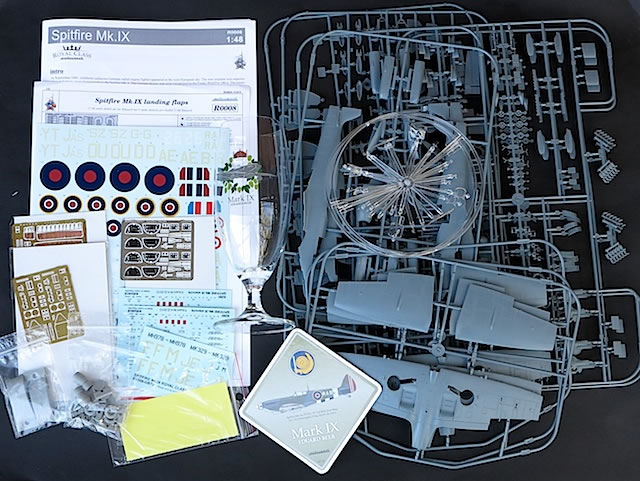
Eduard, 1/48 scale
S u m m a r y : |
Catalogue Number: |
Eduard kit no.R0008 – Spitfire Mk.IX Royal Class |
Scale: |
1/48 |
Contents & Media: |
Approximately 387 grey plastic parts (40 unused); 28 clear plastic parts (1 unused); 1 pre-painted photo-etched fret; 3 unpainted photo-etched frets (2 of these are identical); 18 grey resin parts; 1 sheet of pre-cut canopy and wheel masks; 1 large and 1 small decal sheet of national insignia, codes and individual markings for 14 aircraft; 2 decal sheets of stencils; 28 page full colour instruction booklet; 1 ‘Mk IX Eduard Beer’ glass. |
Price: |
USD$106.25 plus shipping available online from Eduard’s website
and specialist hobby retailers worldwide |
Review Type: |
First Look |
Advantages: |
Excellent base kit; optional parts for completing two different Mk.IX versions (early Mk.IXc, late Mk.IXc and Mk.IXe); high-quality photo-etched and resin details; large number of interesting marking options; bonus beer glass and coaster |
Disadvantages: |
|
Conclusions: |
A comprehensive package that lives up to the standards of previous Royal Edition releases, and is arguably the most complete 1/48 Spitfire Mk.IX kit released by any manufacturer to date. |
Reviewed by
Brad Fallen

Eduard's 1/48 spitfire Mk.IX Royal Class is available online from Squadron.com
The initial development of the Spitfire Mk.IX is well known: an accelerated fusion of Merlin 61 engine and Mk.V airframe in response to the threat posed by the Focke-Wulf Fw 190 A. The resulting aircraft was so successful that it became the second most produced of all Spitfires after the Mk.V, with nearly 5,700 examples built over three years from 1942.
Many changes and improvements were introduced during the Mk.IX production run. These included variations in wing, rudder, elevator, armament, engine, cowling, and carburetor intake types – but this list is far from exhaustive, and references are essential if you want to accurately model a specific aircraft. Useful starting points for exploring the differences between Mk.IXs are the Spitfire Site’s chapter entitled “Spitfire Mk.IX, XI and XVI – variants much varied”, and Robert Humphrey’s SAM Datafile on Merlin-powered Spitfires.
Eduard launched its 1/48 Spitfire Mk.IX series in April this year with a very well received Mk.IXc late version kit. Brett Green noted in his initial in-box review that the kit was ‘fundamentally accurate, well detailed, with state-of-the-art surface textures and lots of useful options’, and concluded that it was ‘easily the best late mark Merlin Spitfire available in 1/48 scale’. Brett’s subsequent build experience (here
http://www.hyperscale.com/2013/features/spitfireixclateeduard48bg_1.htm
and here:
http://www.hyperscale.com/2013/galleries/spitfireixclateeduard48bg_1.htm) reinforced this perception, and indicated that Eduard had cracked the until-now impenetrable nut of an accurate, state-of-the-art Spitfire Mk.IXc kit in 1/48 scale.
Three months on, and Eduard has trumped this debut with a Royal Class boxing that allows modelers to build two aircraft from almost anywhere in the Mk.IX production run, while throwing in a couple of extras to boot.
This is the first Royal Class kit I’ve looked at in detail, and I haven’t been disappointed. The box’s simple outline drawing of a beer-carrying Spitfire is not as evocative as Eduard’s usual art – but it’s what’s inside that counts, and the box is both large and heavy.
Lifting the lid reveals why – the box is very full. Most of the plastic parts will be familiar to anyone who’s completed the Mk.IXc late version kit, with three important differences:
- In addition to the late IXc wings (sprue C), Eduard has included early IXc and IXe wings (sprues B and D). These compare well with photographs of their full-size equivalents, in terms of major features such as cannon bay cover blisters as well as more subtle characteristics like panel and rivet lines.
- Most of the plastic parts present on the sprues in the late IXc kit, but not required for that build, are needed here for the early IXc or IXe kits. Only 20 parts are marked ‘not for use’, and nearly half of these are wheels that are being replaced with resin equivalents. Alternative parts provided include upper engine cowls, elevators, rudders, undercarriage, gun covers, wing tips, fuselage spine plug (with or without I.D. light), and open or closed canopies.
- Because this is a double kit, all of the parts except for the wing sprues are provided in duplicate. There will be plenty of extras left for the spares box, even when you’ve finished both kits.
Eduard’s packaging ensures that all of these parts arrived undamaged; the only item that had separated from its sprue was one of the optional canopy sections.
The quality of the plastic is, I think, a step-up from anything I’ve previously seen from Eduard. Moulding quality is excellent, with no obvious flaws or flash on any of the 11 sprues. Surface detail is exceptionally fine; highlights are the delicately raised cowl fasteners, and the thousands of rivets on the main airframe components. In the past I haven’t been a huge fan of rivets in 1/48 scale, but this kit shows how it can be done. To see what I mean, have a look at Brett’s photographic comparison of the kit’s rivet patterns with those of two Australian-based Spitfires in his review of the late IXc kit.
The clear parts are also very good, being nicely thin and transparent. The clipped wingtips for the two LF IXe marking options are included in these clear parts, presumably to ease painting of the wingtip lights. I like this concept but hope it works in practice, noting the apparent fragility of the thin, clear wingtips – you’ll have to be careful attaching them – and the likely different densities of the clear and standard plastics should any sanding or fettling be required.
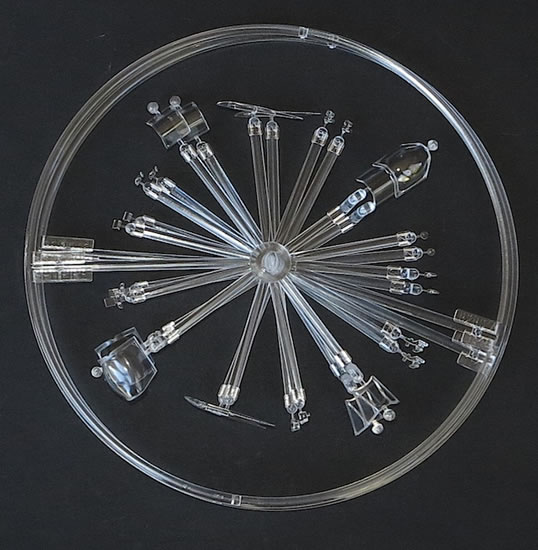
Eduard has backed up these plastic parts with a suite of resin and photo-etched details. Four frets of the latter are supplied – one pre-painted, containing most of the cockpit details, and three unpainted, including two full sets of landing flaps.
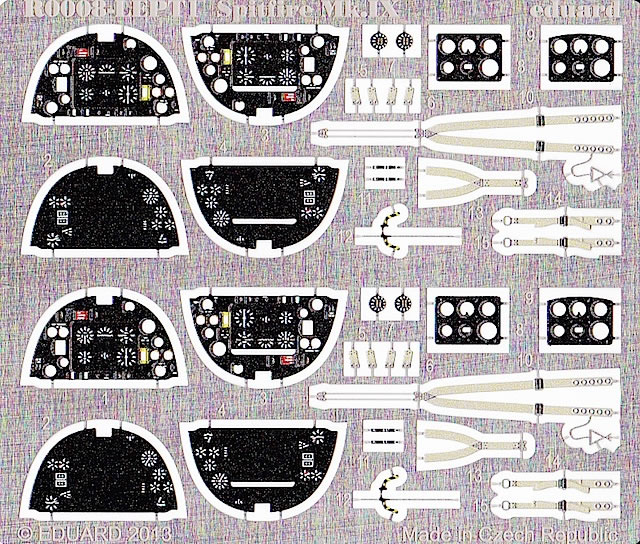
Here again there are options, with the choice of two different instrument panels depending on the aircraft you are modeling.
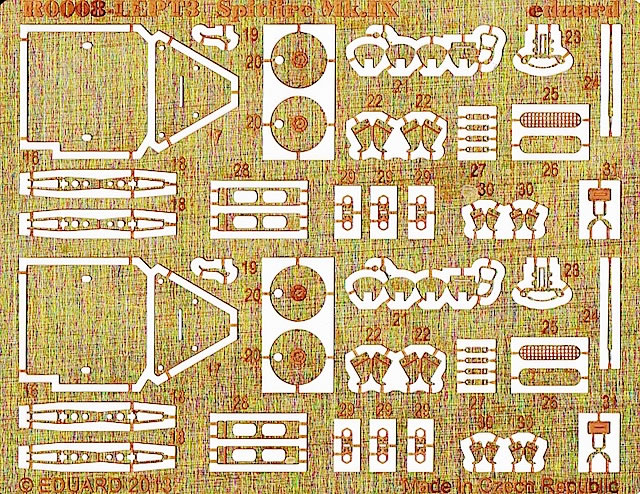
The landing flaps are entirely optional, because Eduard has (thankfully in my view) moulded these closed on the plastic wings. This will suit most modelers, but if you want to drop the flaps then you’ve got the photo-etch to achieve an impressive result – just be prepared to do some cutting and folding!

The Brassin inclusions are comparatively modest, and limited to six wheels (two treaded and four un-treaded), six hubs (two four-spoke and four five-spoke), two slipper tanks and two beer barrels (for marking options N and O).
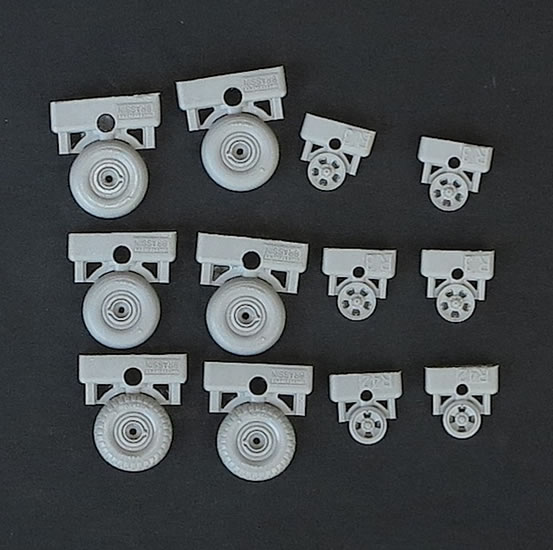
The parts are all perfectly cast and beautifully detailed, with the slipper tanks and barrels particularly exquisite.
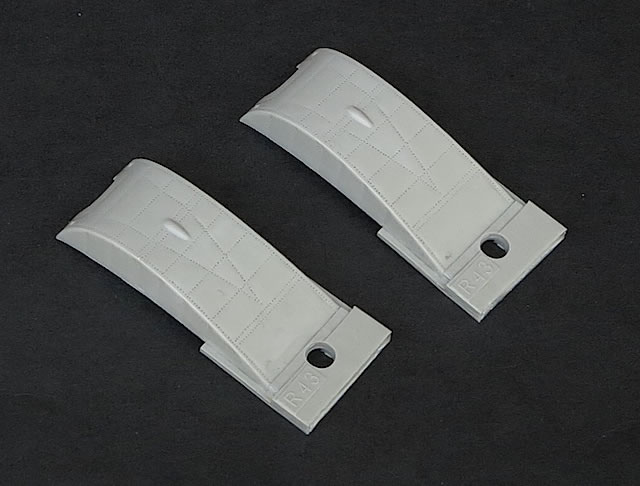
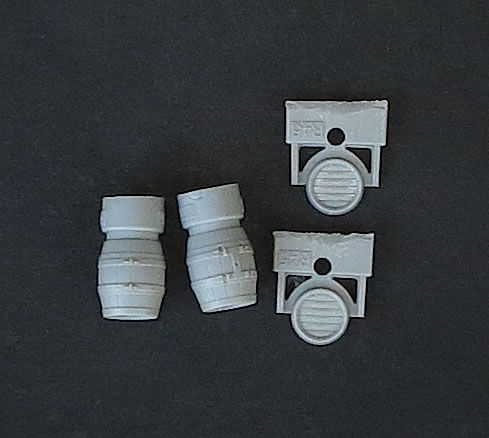
Kabuki tape masks are provided to ease painting of the wheel hubs and clear canopy sections.
Markings
One of the highlights of Royal Class kits is their wide selection of marking options, and this one does not disappoint. Spitfire Mk.IXs were not generally colourful aircraft – most were Dark Green and Ocean Grey over Medium Sea Grey – but within this constraint Eduard has provided 14 varied and interesting marking options. For example, the featured aircraft include:
- Three early Mk.IXc, four late Mk.IXc, four Mk.IXe with standard wingtips and early rudders, one Mk.IXe with standard wingtips and late rudder, and two Mk.IXe with clipped wingtips and late rudders;
- RAF machines flown by Canadian, Polish, Australian, Russian, Belgian, New Zealand, Norwegian, French and Czechoslovak pilots, as well as well as aircraft operated by the United States, Israel and the Soviet Union;
- Five aircraft with invasion stripes; and
- Two carrying beer barrels.

Specific aircraft details are as follows (and no, I haven’t made a mistake – there is no option I!):
- Spitfire F Mk.IXc, MH358/YT-JAS, flown by Squadron Leader James E. Storrer, CO of No. 65 Squadron, based at RAF Kingsnorth, September 1943.
- Sky spinner, fuselage band and code letters.
- Spitfire F Mk.IXc, EN398/AE-B, flown by Flying Officer Ian Keltie of No. 402 Squadron, based at RAF Kenley, March 1943.
- Sky spinner, fuselage band and code letters.
- Spitfire F Mk.IXc, EN526/SZ-G, flown by Wing Commander A. Gabszewicz, CO of Northolt Wing, based at RAF Northolt, Summer 1943.
- Sky spinner, fuselage band and code letters.
- Spitfire LF Mk.IXc, MH779/FU-N of No. 453 (RAAF) Squadron, based at RAF Ford, June 1944.
- Sky spinner, fuselage band and code letters; full invasion stripes.
- Spitfire LF Mk.IXc, WZ-GJ/‘Eleanor’ flown by Major Garth Jared, CO of 309th Fighter Squadron, 31st Fighter Group, USAAF, based at Pomigliano/Castel Volturno, Italy, late 1943 and early 1944.
- Middle Stone and Dark Earth over Azure Blue; red spinner; white codes; overpainted RAF roundels replaced by US national insignia in four positions.
- Spitfire LF Mk.IXc, MH763/RN-S, flown by Prince Emanuel Galitzine, No. 72 Squadron, based at Ramatuelle, France, Autumn 1944.
- Sky and red fuselage band; red spinner; red and white code letters.
- Spitfire LF Mk.IXc, MJ628/R-V, flown by Wing Commander Daniel le Roy du Vivier, CO of No. 324 Fighter Wing, based in Italy, May 1944.
- Dark green fuselage band; red spinner; red and white code letters.
- Spitfire LF Mk.IXe, NH432/OU-D/’Waipawa Special’, flown by Flying Officer Max A. Collet of No. 485 (RNZAF) Squadron, based at Maldegem, Belgium, Autumn 1944.
- Sky spinner, fuselage band and code letters.
- Spitfire Mk.IXe, PV181/RAB, flown by Wing Commander Rolf Arne Berg, CO of No. 132 Wing, based at Twente, the Netherlands, Winter 1944-45.
- Sky spinner, fuselage band and code letters; invasion stripes on lower fuselage and wings; pre-war Norwegian insignia stripes on spinner, rudder and upper and lower wings.
- Spitfire HF Mk.IXe, PT766/2Y-A, flown by Jean-Marie Accart, CO of 345 Squadron, based RAF Deanland, September 1944.
- Sky spinner, fuselage band and code letters; invasion stripes on lower fuselage and wings; overpainted RAF roundels replaced by French roundels in six positions.
- Spitfire LF Mk.IXe, flown by Major Vasiliy Matsyevich, CO of 26th GIAP, Leningrad area, May 1945.
- Eduard notes that the markings of this aircraft are somewhat conjectural, but suggests a white spinner and vertical tail surfaces, and a red-and-white lightning bolt along each side of the fuselage from just behind the spinner to just forward of the tailplanes. Soviet national markings in six positions.
- Spitfire LF Mk.IXe, SL632, 101st Tayeset, Israeli Air Force, late 1949.
- Red and white spinner; red and white striped rudder; Israeli national markings in six positions.
- Spitfire LF Mk.IXe, MH978/M-FF, flown by Squadron Leader Count Franz Ferdinand Colloredo-Mansfeld, CO of No.132 Squadron, 1944.
- Sky spinner, fuselage band and code letters; full invasion stripes; beer keg attached to bomb rack under each wing.
- Eduard notes this marking option is based on a 30-year old profile that is now known to “have no basis in reality”, but which has nonetheless been included because the author of the reconstruction was a pioneering Czech modeler, and because the pilot who flew and died in MH978 was also Czech.
- Spitfire Mk IXe, MK329/JE-J Jr, flown by Wing Commander J. E. Johnson, CO of No. 144 Wing, June 1944.
- Sky spinner, fuselage band and code letters; full invasion stripes; beer keg attached to bomb rack under each wing.
This number of marking options requires a lot of decals. These have been printed on two sheets – one large A4 sized sheet that contains all national insignia, codes and individual aircraft markings, except the codes and serials for the last two options that are supplied on a much smaller supplementary sheet. Two sheets of airframe stencils are also provided.

The large decal sheet has been printed by Cartograf, while the smaller sheet and the stencils have been printed by Eduard. Regardless of their origin, all of the decals are well done. Printing and colour registration are crisp, including on the large number of markings with complex overlapping colours. There is a slight difference in colour between the Sky fuselage codes on the Eduard and Cartograf sheets, but both are within acceptable limits. Instrument panel decals are provided for those modelers who don’t want to use the pre-painted photo-etched panels. The stencil decals are legible, with spelling that appears to be accurate.
Bonus Items
It wouldn’t be a Royal Class kit without at least one bonus item, and this time Eduard has gone with a beer theme to tie in with the barrel-ferrying machines of options N and O. Carefully wrapped in paper and tucked inside a sturdy cardboard box is a handsome Bohemia crystal glass, embossed with a picture of a Spitfire Mk.IX flying through a crowned wreath of hops over the words “Mk IX Eduard Beer”.
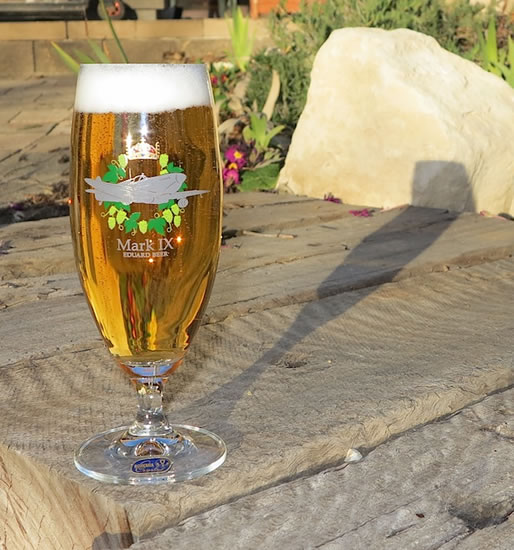
Last weekend I felt compelled to test the glass, and can assure you that it carries out its intended function very well indeed!
Also included is a cardboard beer coaster adorned with the profile of one of the kit marking options – mine has Rolfe Arne Berg’s colourful PV181.
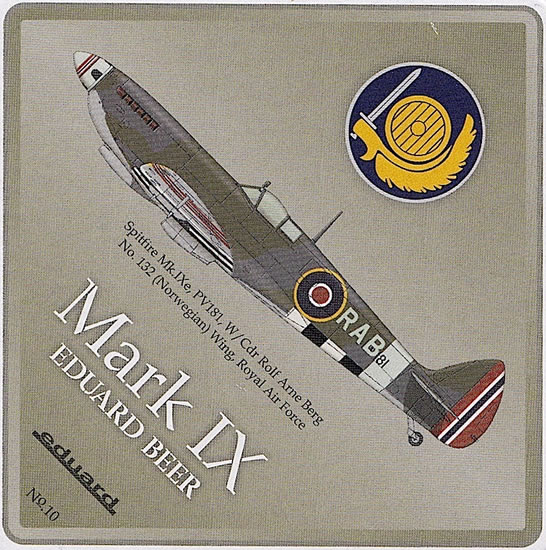
If you want to build up a set, these coasters are available separately from Eduard’s on-line store – although they’re sold in opaque plastic wrappers, so you won’t know what you’re getting until you open the packet.
This kit is a comprehensive package that lives up to the standards of previous Royal Edition releases. The combination of Eduard’s excellent Mk.IX plastic, high quality detailing and optional extras, and 14 interesting marking options make this arguably the most complete 1/48 Spitfire Mk.IX kit released by any manufacturer to date.
The price is also lower than earlier Royal Class kits such as the 1/48 Bf 109 E (USD$150) and Fw 190 A-8/R2 ($160). So, if like me you held off picking up the initial Mk.IX late version kit when it was released back in April, I can highly recommend this boxing as a luxurious introduction to Eduard’s 1/48 Spitfire Mk.IX series.
References
Robert Humphreys, ‘The Supermarine Spitfire – A Comprehensive Guide for the Modeller, Part 1: Merlin Powered’ (SAM Publications, 2000)
Alfred Price, ‘Spitfire in Combat’ (Sutton Publishing, 2003)
Stewart Wilson, ‘Spitfire’ (Aerospace Publications, 1999)
www.spitfiresite.com
Thanks to Eduard for the sample and for the images.
Review Text Copyright © 2013 by Brad Fallen
Page Created 5 August, 2013
Last updated
5 August, 2013
Back to HyperScale Main Page
Back to Reviews Page

|
